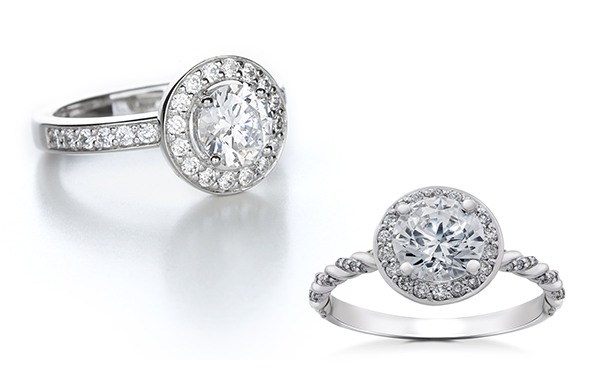
A genuine diamond is the gold standard of fine jewelry, if you’ll pardon the mixed metaphor. Formed in the Earth’s mantle over thousands of years, it is to many the perfect all-natural symbol for pure, everlasting love—a shimmering gem reflecting the brightest light in our hearts.
To just as many, though, a diamond is also a stone mined from the earth that carries with it some potential environmental and ethical baggage. Luckily, an alternative exists: lab-grown diamonds. Long used for industrial purposes, these man-made diamonds are increasingly being used in jewelry as an identical substitute for natural stones. In fact, the only real difference in lab-grown diamonds vs. natural diamonds is how they’re made.

The Difference Between Lab-Grown and Natural Diamonds

Quick, which one is the natural diamond? [Answer]
From a molecular perspective? There’s no difference at all. Unlike imitation stones like cubic zirconia, which look like diamonds, lab-grown diamonds have the exact same chemical composition as a natural diamond—nothing more (or less) than atoms of pure carbon arranged in a crystal structure. The only difference is that diamonds in the ground are compacted over thousands of years. With man-made diamonds, ideal lab conditions speed up the process to only a few hours or days.
Even a trained gemologist wouldn’t be able to perceive the difference between lab-grown and natural diamonds without the aid of advanced equipment (viewing the stone under UV light, for example, reveals tell-tale growth patterns or a glow of a certain color). Nevertheless, there are a few easier ways to determine whether a diamond was created by humans or nature. Lab-created diamonds usually come with a certification identifying them as such, but some manufacturers also etch the stone with a laser inscription, clueing jewelers into their origin.
Overall, when it comes to lab-grown diamonds vs natural diamonds, rest assured: when you’re buying a lab-grown diamond, you are getting a real diamond. Period.
The Benefits of Lab-Created Diamonds

Diamonds grown in a lab have several major benefits compared to mined diamonds—not least of which is the ability to customize them, letting you find the perfect stone without having to beg Mother Nature for any of her precious heirlooms:
More Affordable Diamonds
Lab-grown diamonds are typically 30%–40% less expensive than their natural counterparts
. The price of mined diamonds is determined by fluctuations in supply and demand, along with other factors. Because man-made diamonds exist outside of this supply and demand, they’re generally priced closer to the market’s natural baseline.
Eco-Friendly Diamonds
Even though diamond mining in responsibly regulated nations includes environmental safeguards and land restoration, it still disrupts topsoil, water supply, and wildlife in the short term. Lab-created diamonds remain the most eco-friendly diamonds available, since they help eliminate the need for any environmental disruption.
You can’t create diamonds from scratch, however. All growing processes require the seed of an existing sample to initiate growth. Happily, such seeds are typically lab-grown diamonds, too, meaning the process still alleviates any ecological concerns you might have about ring-shopping. In other words, sporting a lab-grown diamond on your hand goes a long way toward reducing your carbon footprint.
Ethical Diamonds
Before 2003, a small portion of the world's diamond supply originated from illegal trade in certain war-torn countries in Africa. As a result, the market inadvertently included merchandise whose sales could have funded brutal civil conflicts. In addition, some small-scale diamond mines have been found to exploit workers with poor wages and unsafe conditions.
Because a stone’s origin is not always traceable, both of these issues are still possible—albeit unlikely—when purchasing a natural diamond. Thanks to recent efforts led by the United Nations, retailers worldwide have cooperated to ensure that they’re selling only ethical diamonds, reducing the trade of conflict diamonds to less than 1%. Likewise, international efforts continue to crack down on exploitative miners. Lab-created diamonds, however, ensure total peace of mind in this regard: its origin is documented, traceable, and beyond reproach.
Colored Diamonds
Lab-grown options offer a wider selection of colored diamonds—even hues that rarely occur in nature.
Whether you’re looking for a stone that’s perfectly colorless or brilliantly blue, a man-made diamond might be your best bet.
Ideal-Cut Diamonds
If securing an ideal cut is important to your jewelry design, lab-grown diamonds offer the largest selection. Because the process is more controlled, the resulting stones often grade as good or excellent. It takes time to grow a large stone, however, so don’t expect to see many large carat weights. All other guidelines for buying diamonds—from carat weight to clarity—apply to lab-sourced diamonds as well.
How Does the Growing Process Affect the Diamond?
Just as it takes the Earth millennia to form a diamond, it took humans almost as long to figure out to how form their own. Currently, only two processes exist:
High Pressure, High Temperature (HPHT)
Invented in the 1950s, the HPHT technique replicates the natural process to form diamonds, simulating the conditions of the Earth’s mantle.
- Pros and Cons: It’s the simpler process, but it still requires expensive machinery and a significant amount of energy.
- The Results: HPHT mainly produces diamonds with yellowish or brownish colors, though they can be treated afterward to bring about certain hues.
Chemical Vapor Deposition (CVD)
This newer method continues to evolve. At its core, it involves introducing a gas—usually methane—into a vacuum chamber, then breaking down its molecules with microwaves, causing the carbon atoms to slowly accumulate and crystallize below.
- Pros and Cons: It uses smaller and less-expensive equipment and is easier to control than HPHT, though it takes considerably more time, leading to smaller carat weights.
- The Results: CVD can result in a variety of colors, from colorless to blue. Scientists can control the hue by adding trace elements of other gases to the chamber—for instance, nitrogen for yellow, boron for blue, or hydrogen for purple.
While it’s helpful for shoppers to understand the distinctions between the two processes, it shouldn’t affect purchasing decisions. Both processes result in an equally authentic diamond.
Answer: It's the one on the left
Related Guides
 Diamond Buying Guide
Diamond Buying GuideUnderstand a diamond's most important characteristics, so you're confident in the quality and value of your selection.
 Gemstone Buying Guide
Gemstone Buying GuideUnderstand the basics of gemstone jewelry and how it can add a colorful, vivid touch to outfits.












